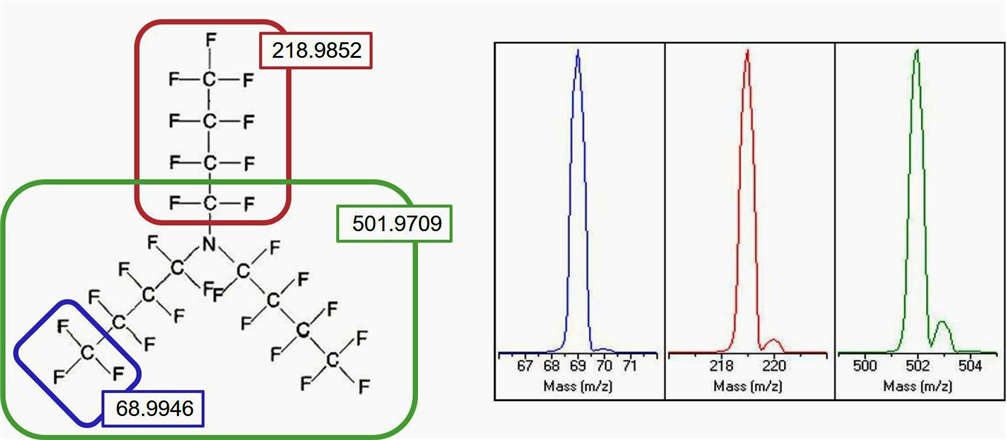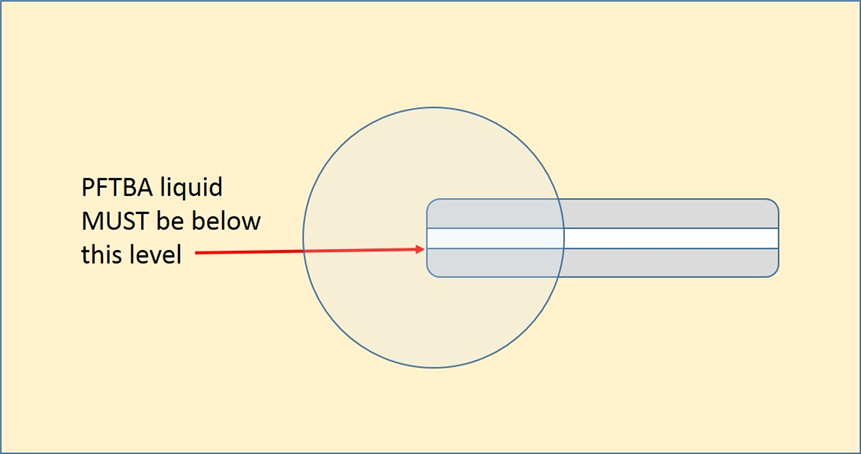Don't Tune So Often !
-------------------------------------------------
GCMS Tuning compound: Perfluorotributlyamine Tris(Perfluorobutyl)amine
PFTBA CAS# 311-89-7 FC43
Agilent part numbers 05971-60571 (0.5ml) 8500-0656 (10g)


PFTBA tuning compound is a higher mass than most analyte peaks. It is 671.096 m/z with a boiling point of 178°C. The act of tuning is a headspace analysis of PFTBA molecules bouncing around the inside of the entire analyzer and it dirties the source the same as samples do. The effects can be seen after thirty or forty tunes on a single quad system and faster on a tandem quad because the tunes are longer. If you are tuning every day, or worse a few times a day because you are worried, you are further contaminating the source.
There is no such thing as perfect tuning. The tune algorithm adjusts parameters every time it is run and so the values are variable. Don’t expect back-to-back tunes to give the same answers with the same setpoints. Tuning is not trying to achieve a singular needle-sharp tip of perfection! It is adjusting multiple parameters for each unique system to be somewhere in the allowable ranges for mass assignment, response across the scan range, and signal response. Most systems could be detuned by 10% to 25% or more and not affect the data.
Chemistry, Physics, Electronics, and the design of Agilent GC/MS systems causes certain answers.
The PFTBA ions created in the ion source and passing through the system are always exact mass: 68.9946, 218.9852, and 501.9709. The ions are always perfect. The filtering, separation, and measurement may or may not be.
The tune ion peak widths and shapes are limited by the eight-inch quadrupole and system/quad cleanliness. A tune ion peak is just a representation of the distribution of the measurement.

The tune ion peak shape, mass assignment, and relative abundances are related to tuning, vacuum, temperature, column flow, carrier gas choice, and more. You gotta run it like you tuned it seems obvious. That seems to surprise some people when I say it, though.
The spectral tilt, the relative abundance of the ions, is affected by the source design, the vacuum, the column flow, column extension distance, gas choice, source temperature, tuning algorithm, quad transmission efficiency, and system cleanliness. This is complicated with many variables.
System cleanliness is crucial. At typical quadrupole MS vacuum, as each compound comes out the end of the column some molecules have reached every bit of the entire surface inside in about 3 seconds or so. As little as ~200 angstroms of adhered semiconductive material, sample and PFTBA residue, impedes the electrostatic charge on lenses, affecting the tuning and ion transmission efficiency. You cannot see 200 angstroms on the metal surfaces, so by the time a source “looks” dirty, it’s been dirty a long time already.
Tuning is not a balancing act on a tightrope, where you have to be perfect or else you’ll fall. It’s up to you to use the system to get good answers – consistently. With less changes. Changing less.
Recommendations:
- Run the source at 275°C and the quad(s) at 150°C. Yes, the 502 relative abundance will be a bit lower than it is with the source at 230°C. Does that really matter for your application? Do you even need increased response above 350 amu? The source will stay cleaner longer as more of the source end of the analyzer is at a higher temperature.
- Inject the smallest volume of the lowest concentrations of samples possible and still see the lowest standard at 3x or 4x the baseline noise. Injecting less means less inlet, column, and ion source maintenance.
- Judiciously use Gain in the method to balance how much is injected with the required multiplier setting. Too high Gain/EMV reduces the lifetime of the EM – an expensive consumable.
- Don’t autotune! Run a standard peak. If the peak is at the right retention time, is the right size within a reasonable range, say plus or minus 20%, and the spectrum looks typical --- RUN. Don’t tune unless something looks bad, and then start with a quick tune first to adjust the least amount possible.
- Clean the source more often. Clean every surface thoroughly but scrub it less. Remove less metal.
-----
110 uL of PFTBA into an empty vial is safely below the opening of the tube as shown here. This is the maximum fill amount.


DE19944709
.
.
.
.
